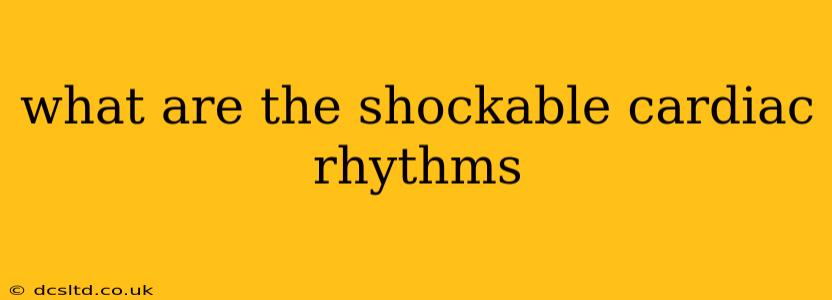What Are the Shockable Cardiac Rhythms?
Understanding shockable cardiac rhythms is crucial in emergency medical situations. Defibrillation, the process of delivering a high-energy electrical shock to the heart, is a life-saving intervention, but it's only effective in specific situations. Improper use can be dangerous, highlighting the importance of accurate rhythm identification. This guide will explain which rhythms are shockable and why.
The key takeaway is that only ventricular fibrillation (VF) and pulseless ventricular tachycardia (VT) are considered shockable rhythms. These are life-threatening arrhythmias where the heart's electrical activity is chaotic, preventing effective pumping of blood.
What is Ventricular Fibrillation (VF)?
Ventricular fibrillation (VF) is a chaotic and disorganized electrical activity in the ventricles. The heart's chambers quiver instead of contracting effectively, resulting in no cardiac output – essentially, the heart stops pumping blood. This is a lethal rhythm requiring immediate defibrillation. On an ECG, VF appears as a disorganized, erratic waveform without discernible P waves, QRS complexes, or T waves.
What is Pulseless Ventricular Tachycardia (VT)?
Pulseless ventricular tachycardia (VT) is a rapid heartbeat originating in the ventricles. While the heart is beating fast, the contractions are ineffective, failing to pump blood throughout the body. This absence of a palpable pulse makes it a life-threatening emergency requiring immediate defibrillation. An ECG tracing of pulseless VT shows rapid, wide QRS complexes without discernible P waves, and critically, no pulse is present.
Why are VF and Pulseless VT the Only Shockable Rhythms?
Only VF and pulseless VT are shockable because these are the only rhythms where a synchronized shock can effectively depolarize a significant portion of the heart muscle simultaneously, allowing it to potentially reset into a normal rhythm. Shocking other rhythms would be ineffective and potentially harmful.
What Rhythms Are NOT Shockable?
Several other rhythms, even if they are fast or irregular, are not shockable and require different treatment approaches, such as medications or other interventions. These include:
- Asystole (flatline): No electrical activity is present; defibrillation would be useless. CPR and medications are the primary treatments.
- Pulseless Electrical Activity (PEA): Electrical activity is present on the ECG, but there is no palpable pulse. The heart's electrical signals aren't effective in producing a heartbeat; defibrillation is not indicated. CPR and medications are needed.
- Organized Rhythms with a Pulse (e.g., Sinus Tachycardia, Supraventricular Tachycardia): While these rhythms may be fast, the heart is still pumping blood; a shock would be dangerous and ineffective.
How is a Shockable Rhythm Identified?
The identification of shockable rhythms requires proper ECG interpretation, training in advanced cardiac life support (ACLS), and the expertise of medical professionals. Laypersons may use automated external defibrillators (AEDs), which analyze the rhythm and advise whether a shock is needed.
Can a Shock Be Delivered Without an ECG?
No. While an AED can provide an analysis for lay responders, accurate identification of shockable rhythms always relies on analyzing the ECG tracing. A trained professional will assess the patient's condition and the ECG to determine the appropriate course of action.
What Happens After Defibrillation?
After defibrillation, immediate CPR is resumed, including chest compressions and rescue breaths, to maintain blood circulation until the heart resumes a normal rhythm spontaneously or other interventions are successful. Continuous monitoring of the patient's heart rhythm is critical.
In conclusion, the ability to accurately identify shockable rhythms (ventricular fibrillation and pulseless ventricular tachycardia) is a cornerstone of emergency cardiac care. The use of defibrillation should only be performed by trained medical professionals or with the guidance of an AED. This underscores the importance of proper training and understanding of cardiac rhythms in emergency situations.
